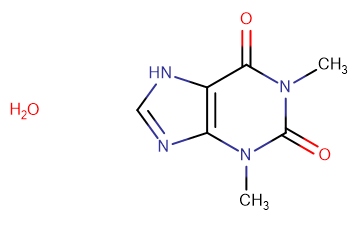
Theophylline monohydrate
CAS No. 5967-84-0
Theophylline monohydrate ( —— )
Catalog No. M15215 CAS No. 5967-84-0
A methylxanthine derivative from tea with diuretic, smooth muscle relaxant, bronchial dilation, cardiac and central nervous system stimulant activities.
Purity : >98%(HPLC)
 COA
COA
 Datasheet
Datasheet
 HNMR
HNMR
 HPLC
HPLC
 MSDS
MSDS
 Handing Instructions
Handing Instructions
| Size | Price / USD | Stock | Quantity |
| 25MG | 34 | In Stock |


|
| 50MG | 45 | In Stock |


|
| 100MG | 59 | In Stock |


|
| 200MG | 106 | In Stock |


|
| 500MG | 146 | In Stock |


|
| 1G | Get Quote | In Stock |


|
Biological Information
-
Product NameTheophylline monohydrate
-
NoteResearch use only, not for human use.
-
Brief DescriptionA methylxanthine derivative from tea with diuretic, smooth muscle relaxant, bronchial dilation, cardiac and central nervous system stimulant activities.
-
DescriptionA methylxanthine derivative from tea with diuretic, smooth muscle relaxant, bronchial dilation, cardiac and central nervous system stimulant activities. Mechanistically, theophylline acts as a phosphodiesterase inhibitor, adenosine receptor blocker, and histone deacetylase activator. Theophylline is marketed under several brand names such as Uniphyl and Theochron, and it is indicated mainly for asthma, bronchospasm, and COPD.
-
Synonyms——
-
PathwayEndocrinology/Hormones
-
TargetAChR
-
RecptorAdenosine receptor; HDAC2; PDE
-
Research Area——
-
Indication——
Chemical Information
-
CAS Number5967-84-0
-
Formula Weight198.18
-
Molecular FormulaC7H8N4O2·H2O
-
Purity>98%(HPLC)
-
SolubilitySoluble in Water
-
SMILESO.CN1C2=C(NC=N2)C(=O)N(C)C1=O
-
Chemical Name——
Shipping & Storage Information
-
Storage(-20℃)
-
ShippingWith Ice Pack
-
Stability≥ 2 years
Reference
1.Nantwi KD, et al. J Spinal Cord Med. 2003 Winter;26(4):364-7
molnova catalog


related products
-
Otilonium bromide
Otilonium bromide is an antimuscarinic.
-
2-Chloroadenosine
2-Chloroadenosine (CADO) is a metabolically stable analog of adenosine that binds to adenosine A1 A2A and A3 receptors( Ki:300 80 and 1900 nM respectively).
-
Pentolinium Tartrate
A nicotinic antagonist that has been used as a ganglionic blocking agent in hypertension.



 Cart
Cart
 sales@molnova.com
sales@molnova.com


